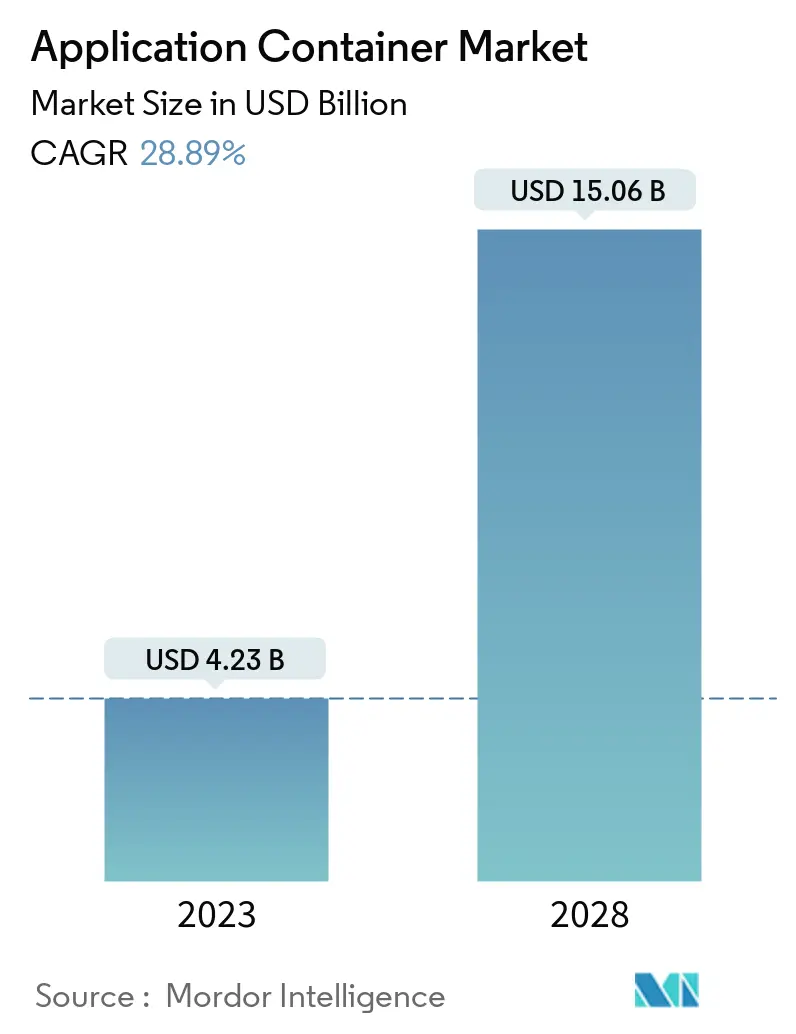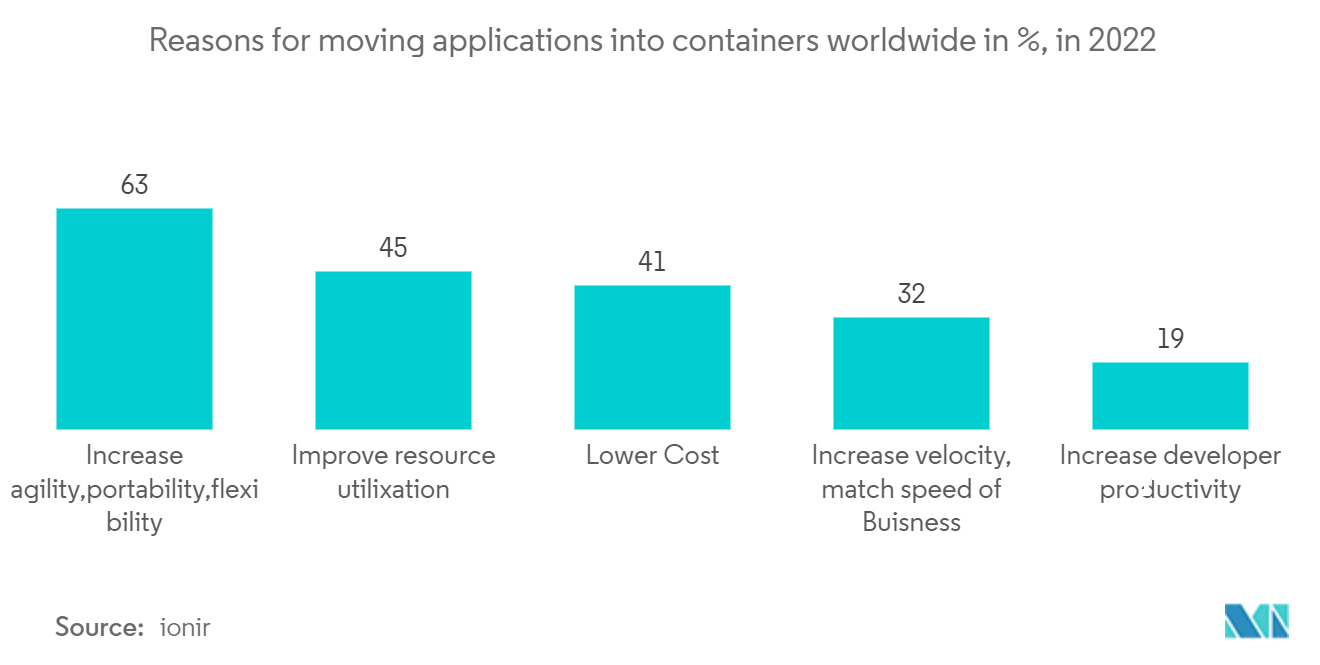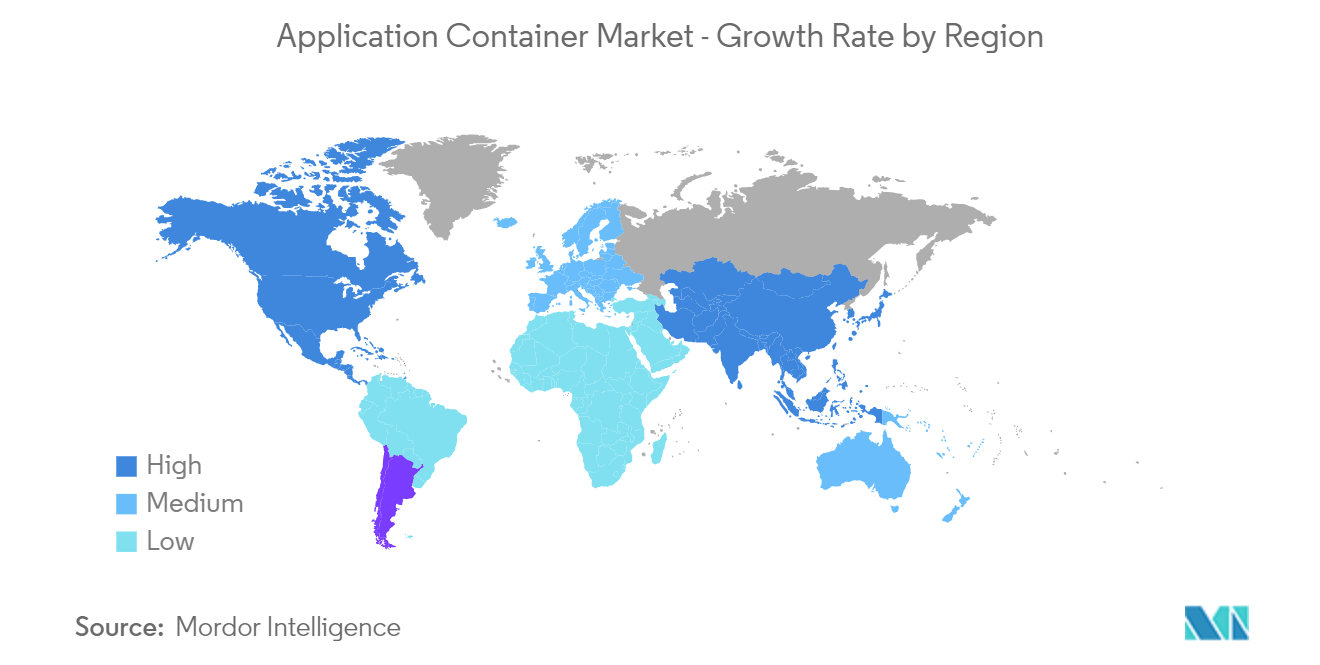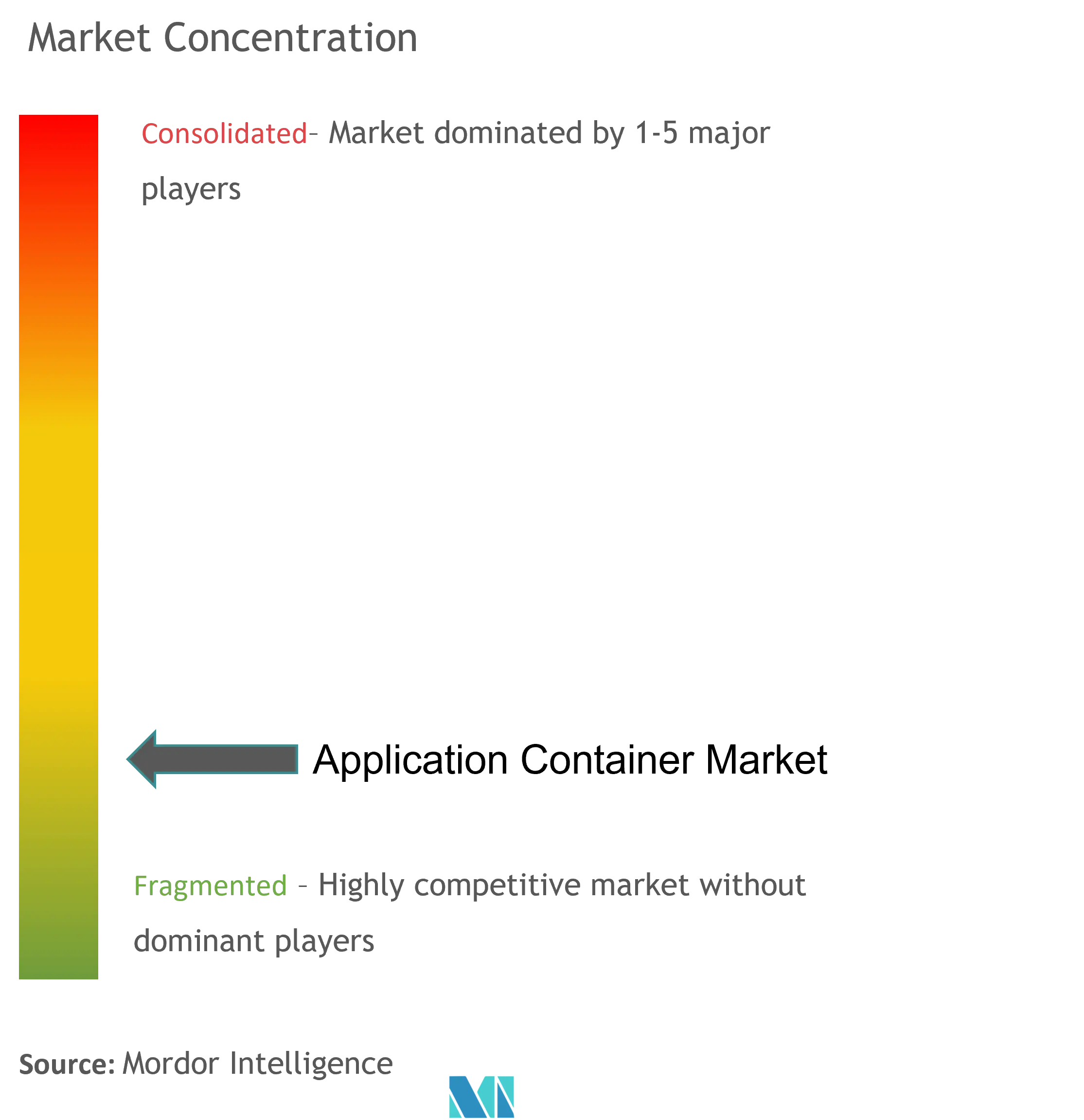Application Container Market Size

| Study Period | 2018 - 2028 |
| Market Size (2023) | USD 4.23 Billion |
| Market Size (2028) | USD 15.06 Billion |
| CAGR (2023 - 2028) | 28.89 % |
| Fastest Growing Market | Asia Pacific |
| Largest Market | North America |
Major Players
*Disclaimer: Major Players sorted in no particular order |
Need a report that reflects how COVID-19 has impacted this market and its growth?
Application Container Market Analysis
The Application Container Market size is expected to grow from USD 4.23 billion in 2023 to USD 15.06 billion by 2028, at a CAGR of 28.89% during the forecast period (2023-2028).
- As part of the digital transformation initiatives, multiple enterprises are primarily focusing on replacing their traditional, manually-based IT tasks with software that can automate the test, configuration, and runtime processes, and containers have emerged as a very critical enabling technology. Organizations can deploy faster, better, and cheaper applications by offering IT organizations a solution to break down applications into more digestible and smaller modules.
- Application Containerization has many benefits over the traditional application environment. For example, Virtual machines can run several operating systems because the hypervisor enables communication between the guest operating system and the host kernel. Still, any installed apps, which are limited to the physical hardware that has been assigned to them, are unable to communicate directly with the host kernel. In this scenario, the application containers directly connect with the host operating system kernel, and the container runtime leverages the underlying operating system, making it a much lighter option.
- Popularized by Docker Inc., the containerization of applications has recently been increasingly adopted. Many organizations are leveraging containers to modernize their legacy apps, streamline infrastructure, and to be able to market their innovations faster. Containers primarily help speed up the applications to market because they offer faster, more consistent release cycles. The application is therefore developed in a container, packaged, tested, and deployed into production. As the application is already being tested in a runtime environment, there is no need for additional testing. Also, much less troubleshooting is required as containers are built to restart when they detect a failure.
- The deployment speed of application containers makes them vulnerable to cyber security risks such as a bug that can be used against a business or a misconfiguration. Enterprises lack visibility into the locations of their mission-critical data as IT infrastructures become more heterogeneous, notably because of the deployment of containers, making them more susceptible to data loss, which is a market challenge for the adoption of application container solutions across industries.
- The COVID-19 pandemic imposed remote working scenarios, which have highlighted the importance of the cloud for business continuity with remote workforces and smooth online communication. Any enterprise's journey toward cloud transformation includes a container strategy. Numerous businesses adopted a container-first strategy because of the flexibility and cost savings that application containers provide, which is creating a demand for the market in the post-pandemic phase.
Application Container Market Trends
Increasing Deployments of Application Container Across Industries
- Organizations in the global retail and e-commerce industry are adopting containers such as the Docker platform to primarily secure and improve their software supply chain and offer seamless DevOps workflows. For instance, Assa Abloy, a Swedish lock manufacturer with increasingly global operations, adopted various strategies to leverage the public cloud, microservices, and containers to fuel their digital transformation further.
- Moreover, with Docker Enterprise, Visa, one of the world's largest retail electronic payments networks, refactored its two critical payment processing applications. They are running on Docker's enterprise container platform, supporting millions of daily transactions. After this implementation in production, Visa achieved a 10x increase in scalability for those two applications.
- While the market is expected to grow significantly, the IT teams report having challenges concerning security. For instance, Tripwire, a cloud company, studied IT security professionals that manage environments with containers. In the study, 60% of them reported having security incidents with their container usage. However, 47% of them responded that they deployed containers with known vulnerabilities. Such statistics prompt the scope for application containers to be substantial over the forecast period, considering the vendors' efforts in the market.
- The development teams at eBay employed Kubernetes to support Docker and Docker containers for development and testing. Additionally, the company started using containers to run production apps. eBay's integration infrastructure has been operating wholly based on containers. The eBay system comprises about 1000 microservices architectures, which are continuously improving and operating according to user expectations.
- NASA's Land Information System traditionally has been difficult to install due to complex software dependencies. With Docker, LIS installation has become much more straightforward, making it accessible to a larger group of users. This shows how Docker can be used to simplify software installation in a setting that you wouldn't traditionally associate with DevOps principles or a fixation on continuous delivery. A segment of the bioinformatics industry is also utilizing Docker container images to build BioShadock, a custom Docker registry for bioinformatics tools and software.

North America Expected to Hold Significant Share
- The North American region occupies the largest market share in the market owing to various factors, such as the gaining momentum of enterprises in microservices architecture and the ongoing transformation of existing business-critical applications that are driving the growth of the market. The continuous increase in financial investments in container technology and the presence of a large number of small and large players in this region are expected to present many opportunities for market expansion shortly.
- The North American region has rapidly adopted cloud and related services. The region has an extensive cloud network that is established by major cloud service providers in this region, which is one of the primary factors fueling the growth of the market. Moreover, this region's increased demand for DevOps has significantly contributed to market growth.
- Further, the region is home to various startups that provide application container solutions, including Bluedata, ClusterHQ, CoreOS, Docker, Sysdig, Twistlock, etc. Multiple standards/guidelines for securing the containerized infrastructure are emerging in the region.
- Organizations in the region are primarily adopting containers to accelerate their software delivery and embrace flexibility in their production environment while moving to the cloud. NIST, a division of the US Department of Commerce, has introduced guidelines that recommend that organizations transform their operational culture and technical processes to support this new way of developing, running, and supporting applications that are made possible by the advent of containerization.
- Many companies are developing security solution for application Containers to increase the reliability and trust of the application container technology in the region, which is driving the adoption of the market in North America. For instance, in October 2022, Veracode, a supplier of application security testing solutions, announced the addition of container security to its Continuous Software Security Platform. The new Veracode Container Security service solved the need for vulnerability scanning, secure configuration, and secrets management for container images. It was created to satisfy the needs of cloud-native software engineering teams.

Application Container Industry Overview
The application container market is highly competitive, owing to the presence of many small and large players operating in domestic and international markets. The market appears to be fragmented, with significant players adopting strategies like product innovation, and the emergence of various start-up companies is marking the market dynamic. Some of the market's major players are Amazon Web Services, Inc., Google LLC, and Microsoft Corporation.
In December 2022, Red Hat OpenShift certification for Red Hat Enterprise Linux was made available to DH2i's DxEnterprise multi-platform smart clustering software. With this certification, Red Hat OpenShift and Red Hat Enterprise Linux could confirm that the company’s containerized solution would accelerate the development of intelligent applications across hybrid and multi-cloud environments. Red Hat OpenShift and DxEnterprise could be used to create lightweight execution environments for applications, enabling enterprises to deploy essential workloads across physical, virtual, private, and public cloud and edge environments more quickly and consistently.
In July 2022, ABB and Red Hat announced a global partnership to assist industries using ABB's process automation and industrial software scale rapidly and flexibly by utilizing Red Hat's market-leading enterprise platforms and application services built on Red Hat Enterprise Linux. The partnership with Red Hat OpenShift has made ABB possible to virtualize and containerize automation software to provide extremely flexible hardware deployment that has been suited to the needs of the application. It has been providing efficient system orchestration, allowing for real-time, data-driven decision-making at the edge and additional processing in the cloud.
In June 2022, Sysdig, a company in unified cloud and container security, and Coforge partnered to provide visibility across cloud & container workloads from source to run, enabling customer success in the new multi-cloud world. By addressing critical security concerns and operating Kubernetes with containers in multi-cloud production environments, Coforge would offer container services to assist enterprises in decreasing risk and providing reliable cloud applications.
Application Container Market Leaders
Amazon Web Services, Inc.
Google LLC
Microsoft Corporation
Docker Inc.
Red Hat Inc.
*Disclaimer: Major Players sorted in no particular order

Application Container Market News
January 2023: Landis+Gyr, a global company in energy management systems, and MicroEJ, the supplier of software containers for IoT and embedded devices, announced their partnership to improve the app development environment for the following generation of smart meters. This partnership would set the digital groundwork for more effective and environmentally friendly energy management.
October 2022: Oracle introduced to offer of serverless Kubernetes container management. Enterprises struggle to build and operate cloud-native apps efficiently, but by using Oracle Container Engine for Kubernetes Virtual Nodes infrastructure, companies could build applications more easily. Additionally, Virtual Nodes enable customers to deliver trustworthy Kubernetes operations at scale without maintaining any infrastructure.
Application Container Market Report - Table of Contents
1. INTRODUCTION
1.1 Study Assumptions and Market Definition
1.2 Scope of the Study
2. RESEARCH METHODOLOGY
3. EXECUTIVE SUMMARY
4. MARKET INSIGHTS
4.1 Market Overview
4.2 Industry Attractiveness - Porter's Five Force Analysis
4.2.1 Threat of New Entrants
4.2.2 Bargaining Power of Buyers/Consumers
4.2.3 Bargaining Power of Suppliers
4.2.4 Threat of Substitute Products
4.2.5 Intensity of Competitive Rivalry
4.3 Use Cases
4.3.1 Management and Orchestration
4.3.2 Monitoring
4.3.3 DevOps
4.3.4 Security
4.3.5 Networking
4.3.6 Storage
5. MARKET DYNAMICS
5.1 Market Drivers
5.1.1 Increased Adoption of Cloud-based Computing
5.2 Market Restraints
5.2.1 Security Risks Associated With the Technology
6. MAJOR CONTAINER USE-CASE AREAS
6.1 Management and Orchestration
6.2 Monitoring
6.3 DevOps
6.4 Security
6.5 Networking
6.6 Storage
7. MARKET SEGMENTATION
7.1 Geography
7.1.1 North America
7.1.1.1 United States
7.1.1.2 Canada
7.1.2 Europe
7.1.2.1 United Kingdom
7.1.2.2 Germany
7.1.2.3 France
7.1.2.4 Spain
7.1.2.5 Rest of Europe
7.1.3 Asia-Pacific
7.1.3.1 China
7.1.3.2 India
7.1.3.3 Japan
7.1.3.4 Rest of Asia-Pacific
7.1.4 Latin America
7.1.4.1 Brazil
7.1.4.2 Argentina
7.1.4.3 Mexico
7.1.4.4 Rest of Latin America
7.1.5 Middle East and Africa
7.1.5.1 United Arab Emirates
7.1.5.2 Saudi Arabia
7.1.5.3 South Africa
7.1.5.4 Rest of Middle East and Africa
8. COMPETITIVE LANDSCAPE
8.1 Company Profiles
8.1.1 Engine Yard Inc.
8.1.2 Docker Inc.
8.1.3 Amazon Web Services Inc.
8.1.4 Google LLC
8.1.5 Microsoft Corporation
8.1.6 Oracle Corporation
8.1.7 Red Hat Inc.
8.1.8 Joyent Inc. (Samsung)
8.1.9 Heroku Services (Salesforce.com)
- *List Not Exhaustive
9. COMPARATIVE PRODUCT ANALYSIS
10. MARKET OPPORTUNITIES AND FUTURE TRENDS
Application Container Industry Segmentation
The Application Container is a standard unit of software that packages up code and all its dependencies so that the applications run quickly and reliably from one computing environment to another. Application containers consume fewer resources than a comparable deployment on virtual machines because containers share resources without a full operating system to underpin each app. Containers are software packages that come with everything needed to execute in any environment. Containers virtualize the operating system in this manner, enabling them to run anywhere, even on a developer's personal laptop or on a public cloud.
The Application Container market is segmented by Geography (North America, Europe, Asia-Pacific, Latin America, and Middle & Africa). The market sizes and forecasts are provided in value (USD million) for all the above segments.
The application Container Market is expected to grow at a CAGR of 29% during the forecast period.
| Geography | |||||||
| |||||||
| |||||||
| |||||||
| |||||||
|
Application Container Market Research FAQs
How big is the Application Container Market?
The Application Container Market size is expected to reach USD 4.23 billion in 2023 and grow at a CAGR of 28.89% to reach USD 15.06 billion by 2028.
What is the current Application Container Market size?
In 2023, the Application Container Market size is expected to reach USD 4.23 billion.
Who are the key players in Application Container Market?
Amazon Web Services, Inc., Google LLC, Microsoft Corporation, Docker Inc. and Red Hat Inc. are the major companies operating in the Application Container Market.
Which is the fastest growing region in Application Container Market?
Asia Pacific is estimated to grow at the highest CAGR over the forecast period (2023-2028).
Which region has the biggest share in Application Container Market?
In 2023, the North America accounts for the largest market share in the Application Container Market.
Application Container Industry Report
Statistics for the 2023 Application Container market share, size and revenue growth rate, created by Mordor Intelligence™ Industry Reports. Application Container analysis includes a market forecast outlook to 2028 and historical overview. Get a sample of this industry analysis as a free report PDF download.
